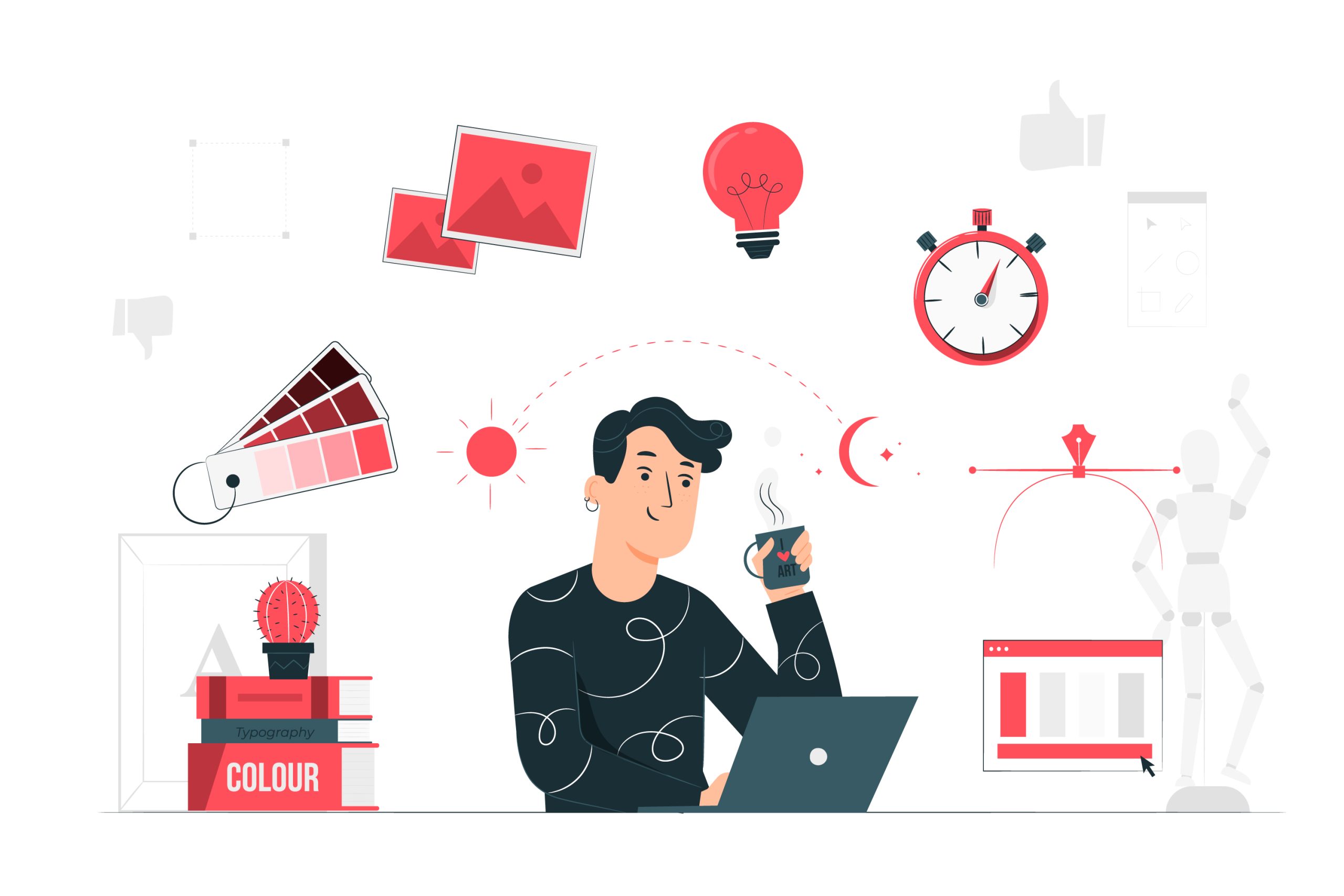What Is UX Design?
UX means User Experience. UX design focuses on the experience of a user relating to a product or a service. The goal of the UX design is to ensure enhanced satisfaction and overall experience, meeting the user’s expectations and needs. UX design involves understanding user needs, pain points, behaviors, and satisfaction levels through research and testing by creating user performances, personas, prototypes, and wireframes. This design improves the usability, accessibility, and pleasure of interacting with a product or a service.
What Is UI Design?
UI means User Interface. UI design is more concerned with the look and feel of the product’s interface. UI design focuses on the graphical elements that the users interact with. UI design ensures the design, and visual layouts including buttons, icons, typography, and color schemes are engaging enough for the users for easy navigation and promote enhanced overall user experience. The design ensures the interface is aesthetically pleasing, consistent, and aligns with the particular brand’s identity.
Top 10 UI/UX Designer Skills to Boost Your Career
(Overview and structure)
1. User Research and Analysis
- Gathers insights about user needs, behaviors, pain points, and customer satisfaction levels through methods like surveys, interviews, and observations.
- User research leads to a more effective and user-centered design catering to the user’s expectations and needs.
- Helps the designers to understand their target audience and make design decisions to ensure the product meets the user’s expectations and needs.
2. Wireframing and Prototyping
- Creates basic layouts and structures of a product, focusing on functionality.
- Wireframing and Prototyping are useful for creating visualizing and iterating designs for development.
- Both help in ensuring functionality and user flow based on expectations and needs.
- Rather than aesthetic building, both wireframing and prototyping help to build interactive models of the design to test and refine concepts.
3. Visual Design Skills
- Encompasses the aesthetics of product typography, iconography, and color schemes.
- Effective visualization designs help to improve usability and enhancement by providing clarity and focus based on specific needs and expectations.
- The visual design creates a visually appealing and cohesive interface with colorful schemes aligning with the brand identity and enhancing the user experience.
4. Interaction Design
- It focuses extensively on the user’s interaction with the product or service.
- The interactive design includes the design of interactive elements like buttons, feedback, and gestures.
- These designs guide the users through tasks by enhancing their overall experience to meet their expectations and needs.
- These interactive designs are intuitive, efficient, and satisfying to navigate the users through their experience.
5. Usability Testing
- Involves evaluating a product or service by observing real users as they perform tasks.
- Usability testing ensures that the product or service is easy to use, and access, meets user needs, and provides a positive and comprehensive experience.
- Usability testing helps to identify the issues, gather feedback, and understand user behavior.
6. Familiarity with Design Tools
- Software tools such as Abode XD, Figma, and Sketch are used to create and refine the designs.
- Familiarity with these design tools and others is important to create the overall user experience.
- Proficiency in these tools enables designs to efficiently produce wireframes, prototypes, interactive designs, and the usage of visual elements for collaboration with the user’s needs and expectations.
7. Responsive Design
- Ensures the product works well across various devices and screen sizes.
- Responsive device designs provide a consistent and optimized user experience, be it on desktop, desktops, tablets, mobiles, or other smart devices.
- Responsive design involves creating flexible layouts and elements that adapt to different resolutions by providing smooth workflows.
8. Communication and Collaboration
- Communication and collaborative skills are vital for working efficiently with team members to build teamwork amongst the members, stakeholders, and clients.
- As UI and UX design are technical, designers need to clearly articulate their ideas, listen to feedback express their ideas, and work collaboratively to ensure the designs align with the project goals, client goals, and user needs.
9. Problem-solving and Critical Thinking
- Problem-solving and Critical thinking skills are vital in analyzing the design challenges.
- Adapting these skills generates solutions and evaluates their effectiveness.
- Designers should adapt these skills to address user needs and overcome design constraints, and other obstacles to make informed decisions which helps in enhancing the product’s functionality and user experience.
10. Keeping Up with Trends and Technology
- Keep up with trends in technology and emerging advancements to stay informed about design practices, tools, and decision tools.
- The designers should keep up and continuously learn and adapt to new trends to create innovative and relevant designs.
- This helps to meet modern user expectations and industry standards, further opening up a plethora of opportunities across various industries in the world.
Salary Offered to UI/UX Designers
The following are the average annual salaries offered to UI & UX designers in India and below are the factors that influence the pay.
| Entry-Level (₹)(0 – 2 years) | Mid-Level (₹)\(2 – 5 years) | Senior-Level (₹)(5 + years) | |
| Salary Range | 3 – 6 lakhs p.a. | 6 – 12 lakhs p.a. | 12 – 20 lakhs p.a. |
| Influencing Factors | Educational Degree,Certifications,Internship Programs. | Industry Demands,Experience in entry-level jobs | Experience in Project Management, Specialization in UI & UX design. |
Other factors influencing the salaries of UI & UX designers:
- Location – Salaries to UI & UX designers are higher in top-tier cities like Bangalore, Mumbai, Delhi, Chennai, and Hyderabad as these are hubs for major IT industries and Digital Marketing Agencies. Salaries are flexible based on the remote work and the employer’s location.
- Company Size – Startup companies offer stock options or equity for salary payments ensuring their position to be sustained during the growth of the company. Established companies offer higher salaries with additional perks.
- Skill Sets – The UI Ux designers are supposed to possess proficiency in tools like Figma, and Sketch, and expertise in user research.
Conclusion
Mastering the above skills such as user research, wireframing, prototyping, interactive design, visual layouts, and usability testing shall place you in a significant position. Catching up with the further trends and industry demand shall boost your career, cementing you as a sought-after professional in the competitive and dynamic field.
FAQs
What is the importance of user research and analysis in UI/UX design?
User research and analysis provide insights into users’ needs, expectations, desires, behaviors, pain points, and satisfaction levels. These guide to making decisions to create intuitive user-centered interfaces to enhance satisfaction and usability.
How do wireframing and prototyping contribute to the design process?
Wireframing and prototyping contribute to saving time and resources by allowing designers to identify potential issues, gather feedback, and iterate before final development.
Why are visual design skills critical for UI/UX designers?
Visual design skills are used to ensure the interfaces are aesthetically pleasing and align with the brand’s identity. Visual design skills help to effectively communicate the information, enhancing user engagement in the overall experience.
What role does usability testing play in UI/UX design?
Identifies design flaws, assesses ease of use, and ensures the product meets user needs. The role of usability testing leads to an effective and user-friendly interface.
How can staying updated with trends and technology benefit a UI/UX designer?
Staying updated can help them innovate, adapt, and incorporate the latest tools and techniques and ensure more competitive, modern, and relevant designs.

